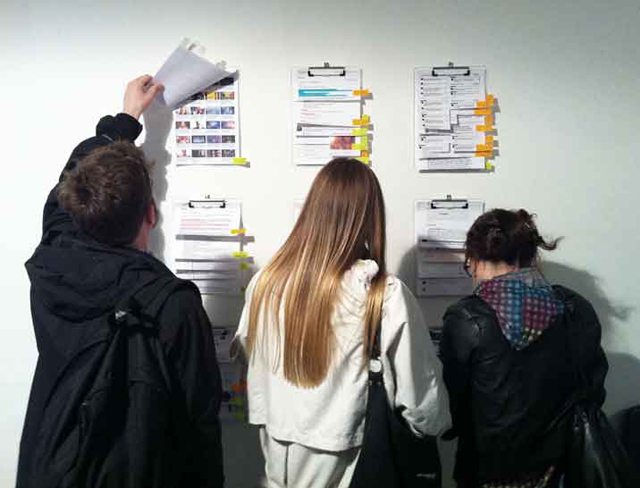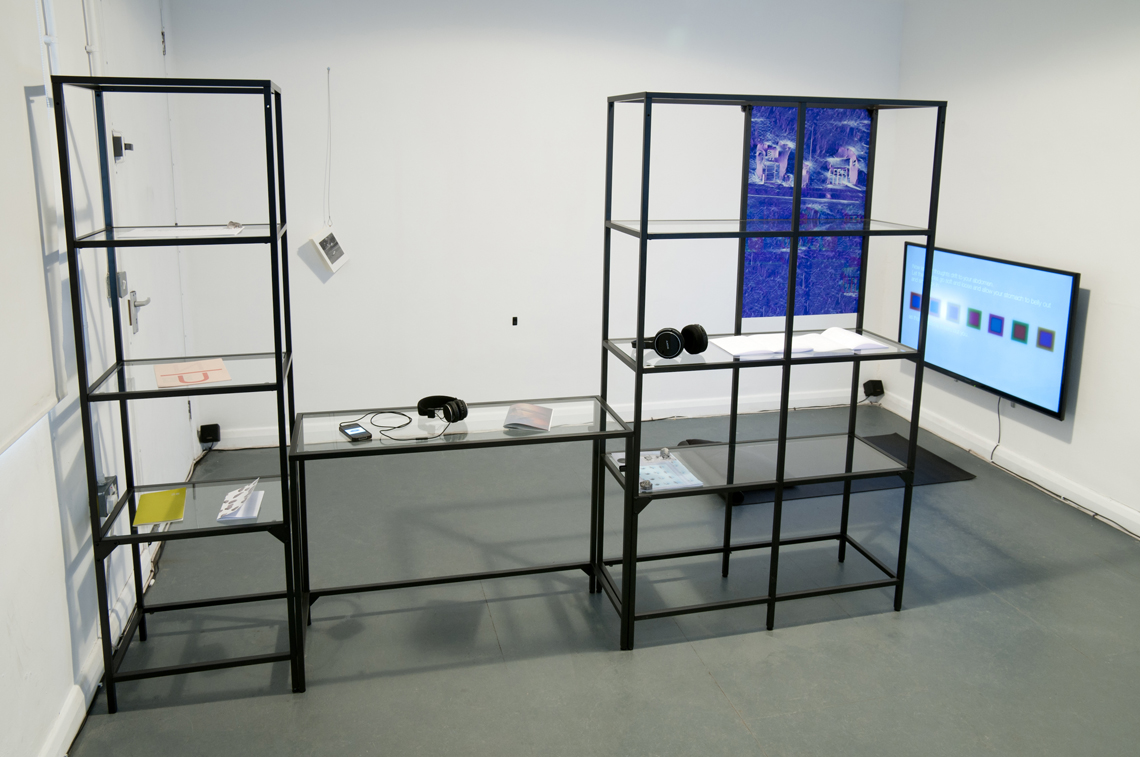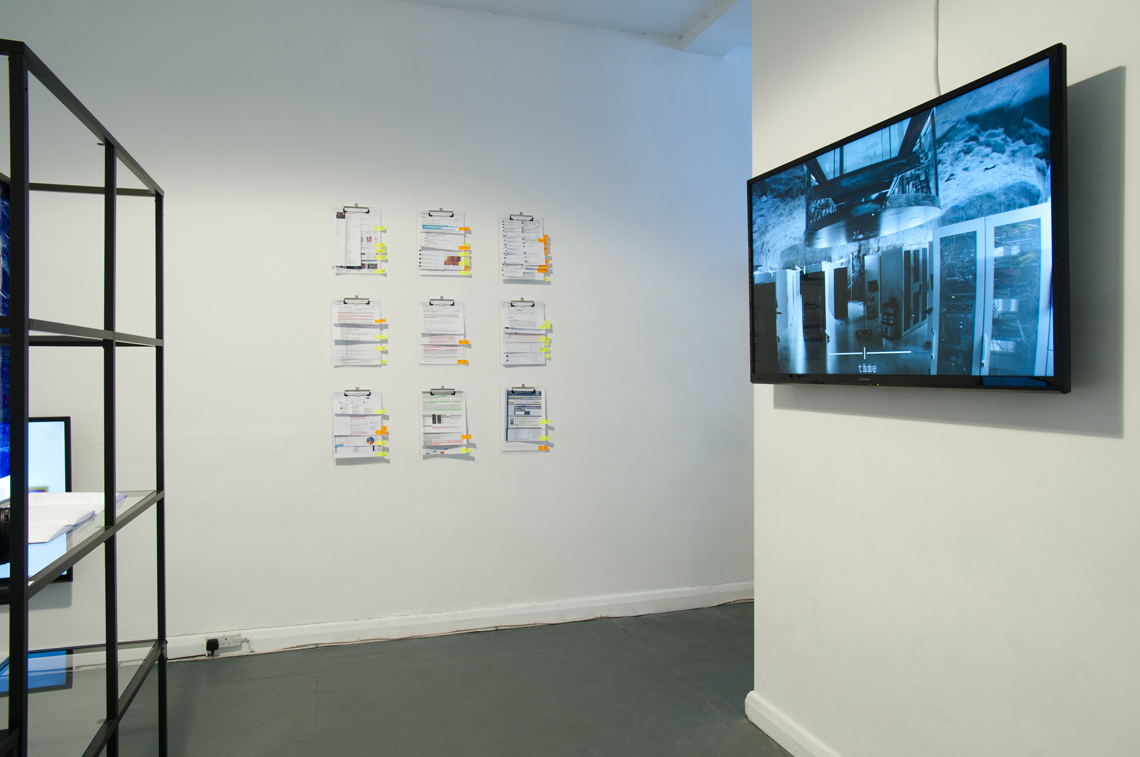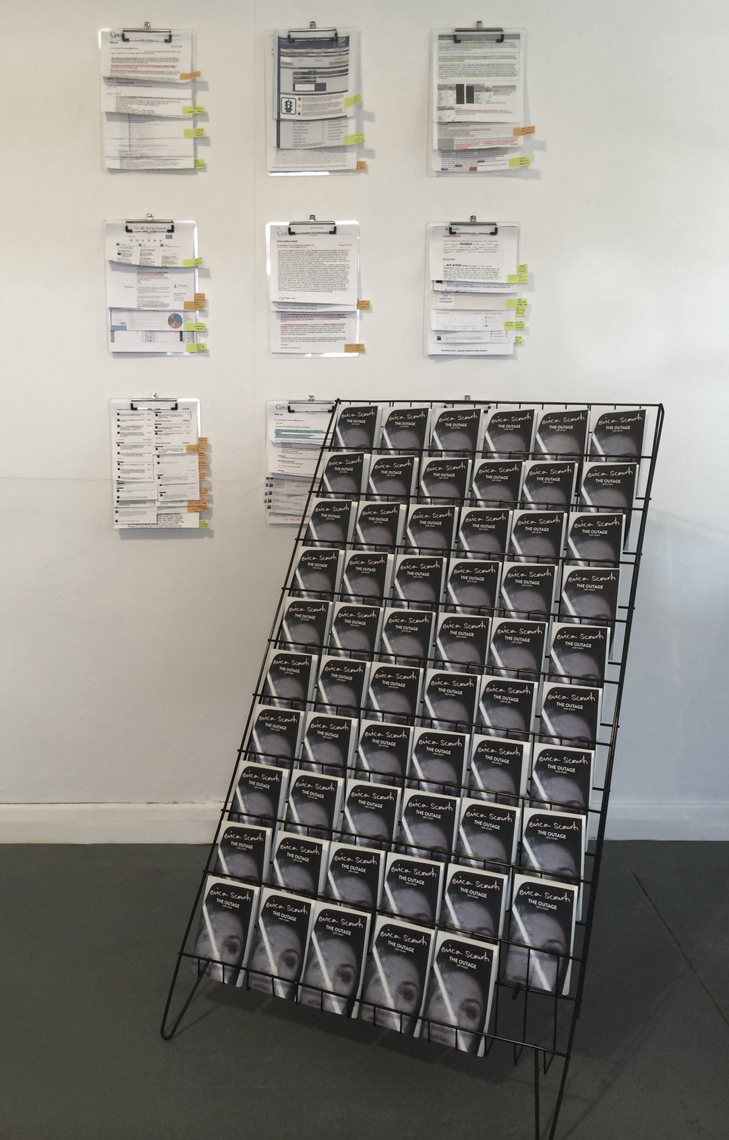“I had registered and dissolved. Into code. Into data”, writes J. A. Harrington, acting as conduit to the thoughts of artist Erica Scourti in a ghost-written memoir. The Outage: Her Story (as constructed by Him) is the culmination of mostly public, sometimes private data collected from the internet and surrendered to a stranger to give it subjectivity.
As part of London project space Banner Repeater’s Snow Crash program, run throughout June and July and taking its title from the 1992 science fiction novel by Neal Stephenson of the same name, the exhibition reflects the overwhelming idea of Big Data through a space brimming with information. “Everyone’s producing an image of themselves for an algorithmic gaze, intentionally or not”, says Scourti during the Unidentified Fictionary Objects artist talk launching The Outage, as one considers the grid-like shelving of the Snow Crash exhibition, presenting printed images and words, with its own internal logic.

There are connections to be made here, each one specific to a contextual intersection –physical, ideological, personal –as one discerns a Cartesian reference in Ami Clarke‘s ‘Impossible Structures “the eye that remains of the me that was I” (Error-Correction: an introduction to future diagrams: take 3)’ Android app, becoming barely decipherable through the cloudy ebb of its looping computer melody, only to re-emerge elsewhere. “A Cartesian system of abstract ground: space as a whole” repeats a quote from Clarke’s Error-correction –take 3 –a script. It’s a shiny print zine lying on a shelf with her UN-PUBLISH (2.01), a meta-fiction taken from the IM conversations of bradass87, ie. Chelsea (aka Bradley) Manning, first released by Wired in 2011 a year after her arrest.
Published in parallel with the exhibition, the countless covers of Scourti’s book come in a display stand in one corner, featuring a self-portrait that is filtered, reformatted and endlessly reproduced from a photo on an iPhone. Above it hang reams of printed research information –email correspondence, Facebook comments and data research profiles. Too much to process. “The more information there is, the more any sense of narrative dissolves into itself”, says Harrington during Unidentified Fictionary Objects, pointing to how banal the unfiltered individual, raw data, really is.
There’s a list of NSA trigger words on the wall behind The Outage, ranging from ‘eavesdropping’, ‘debugging’ and ‘interception’ to ‘porno, ‘artichoke’ and ‘badger’. On one of the shelves sits a Russian-to-English translation of V. F. Odoevsky’s 4338 AD 19th century prose by Yuri Pattison, the strikethroughs and comments left behind by its translator illustrating the problem of what’s lost in the conversion. In an imagined future where its protagonist Hippolytus Tsungiev considers the “huge bundles of material” left behind by the now extinct ‘Germans’ suggesting “some sort of caste or class”, it occurs to him that “a lot must depend on the work of your curators of antiquities”.
The same applies to The Outage when its first-person persona asks, “how were you supposed to enjoy looking for personal meaning in the souvenirs of that class of people who manipulated history to your exclusion?” It’s probably that same class that threatened to discharge a gender dysphoric Manning from the US military for “occupational problem and adjustment disorder”. Jesse Darling’s EMDR (eye movement desentization and reprocessing) video comes as a deeply troubling reaction to the trauma of sexual oppression and intrusion in a “self-administered” therapy session for the treatment of its after-effects. “Now try to imagine yourself as a whole”, goes the potential pun of its ‘healing’ visual script before ending on the violence of, “now allow this to wrench you apart”.
“It became difficult to disentangle the emotion of feeling psychotic from its consumer experience”, states The Outage, in recognising that “the domain of private, interior human communication had already been absorbed by nano targeted advertising. To project who your search engine thinks you are”. The generalised question of Snow Crash then becomes, ‘who are we and what do we actually know, if anything? As Odoevsky’s Tsungiev character grieves the disappearance of paper-written records as the accelerated disintegration of historical documentation, this next stage of communicative (d)evolution into the mass ‘digitisation’ of our archival memory on to soon-to-be-obsolete hardware makes this issue only more urgent. The ideas of 4338 AD not only sit in parallel to but is literally facing Pattison’s ‘In colocation, time displacement’ (2014) film piece, featuring footage taken from inside Sweden’s Pionen datacentre, host to Wikileaks, using legacy lenses incompatible with the HD camera being used.
Near to 4338 AD, Clarke’s UN-PUBLISH (2.01) –‘Is it built around a formula? the air gap has been penetrated’ is the first of a series named after the concept of ‘un-publishing’ as understood by Julian Assange, where online data is easily manipulated, “in that it is exceptionally easy to delete”. It’s an idea that has implications for the future but also, particularly for the present. When considering the disturbing legislation over the recent “right to be forgotten” ruling, the question is, a right for whom? bradass87 had little control over the dissemination of, not only her private records (a control that the State insists on), but even her own self-representation:
“i wouldn’t mind going to
prison for the rest of my life, or being executed so much, if it wasn’t for the
possibility of having
pictures of me… plastered all over the world press… as boy”

Ironically, in the act of taking this conversation and embedding it in the finality of print form, Clarke herself has appropriated authority over Manning’s image, however sympathetically, in the same way that Scourti had delivered hers into Harrington’s. But, as Scourti herself says in conversation, “I never imagined that what I was putting across was some kind of authentic coherent self, mainly because I don’t believe that exists. I see that as more a historically contingent construction”. Thus the illusion of reality, truth, freedom.
“Intentionality, he argues, is a biological phenomenon”, writes Tyler Coburn in Robots Building Robots, a travelogue of sorts written alongside improvised performances in a Taiwanese science park and dangling from a chain in a corner of Snow Crash. It’s a quote from philosopher John Searle illustrating the core distinction between human and machine at the same time as the simulated voice of Anna Barnham‘s Penetrating Squid audio disrupts it. A randomly generated sequence of text tells “like you intention is one hot machine” its weight coming through the interpretation and not the motive behind what’s been complicated by computer processes.
Coburn’s “infantilism of machinic dependence” echoes Scourti/Harrington’s exposure and anxiety of online dependence in The Outage: “I’ve been taken so far against my will for so long that I’ve forgotten how to do it on my own.” All this, in the turmoil of too much information; a vortex of “pure language which no longer mean[s] or expresse[s] anything.**
Exhibition photos, top-right.


















